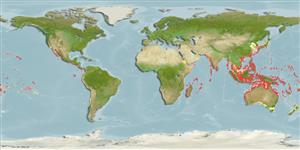Common names from other countries
Classification / Names / Names
ชื่อสามัญ | ชื่อพ้อง | Catalog of Fishes (gen., sp.) | ITIS | CoL | WoRMS
Environment: milieu / climate zone / depth range / distribution range
นิเวศวิทยา
; ระดับความลึก 0 - 53 m (Ref. 102117). Tropical
Indo-Pacific: from Eritrea to South Africa to Madagascar and India, including Western Australia, Andaman, Nicobar and Christmas Islands and from China to the South China Sea, Australia, including Federated States of Micronesia, Fiji, and French Polynesia; from east to Chile, including American Samoa, Samoan Archipelago, Cook and Hawaiian Islands.
Length at first maturity / ขนาด / น้ำหนัก / Age
Maturity: Lm ? range ? - ? cm
Thalli erect and tough, dark brown, attached to rocky substrate by coarse branched holdfasts. Alternating turbinate, fleshy leaves with a terete stalk, crowded along the erect axis; distal end of leaves expanded to form a somewhat circular and fleshy marginal blade, outlined by sharp and coarse teeth; centre of blade concave and conspicuously surrounded, partially or fully, by a crown of teeth; single vesicles may be found at the depressed centre, usually among the leaves at the upper portion of the thallus. Receptacular branches racemose, 5 to 7 mm long, attached to the stalk of the leaves, about 1/3 the distance from the base, their distal portions irregularly forked. Thalli up to 17 cm in height (Ref. 80758).
Used for human consumption, as insect repellant and fertilizer; source of algin, tannins and
phenols (Ref. 80758). Thrives mostly on rocky reef areas exposed to strong water turbulence, also on coralline rocks in calmer waters, commonly partially exposed during very low tides (Ref. 80758).
Guiry, M.D. and G.M. Guiry. 2009. (Ref. 80701)
IUCN Red List Status (Ref. 130435)
CITES status (Ref. 108899)
Not Evaluated
Not Evaluated
Threat to humans
Human uses
การประมง: การค้า
| FishSource |
เครื่องมือ
ข้อมูลเพิ่มเติม
ชื่อสามัญชื่อพ้องผู้ล่าการสืบพันธุ์วัยเจริญพันธุ์การวางไข่ความดกของไข่เซลสืบพันธ์ของเพศเมีย(ไข่)Egg development
Age/SizeการเจริญเติบโตLength-weightLength-lengthสัณฐานวิทยาตัวอ่อนอุดมสมบรูณ์
แหล่งที่มาจากอินเตอร์เน็ต
Estimates based on models
Preferred temperature
(Ref.
115969): 20.6 - 29.1, mean 28 (based on 1626 cells).
